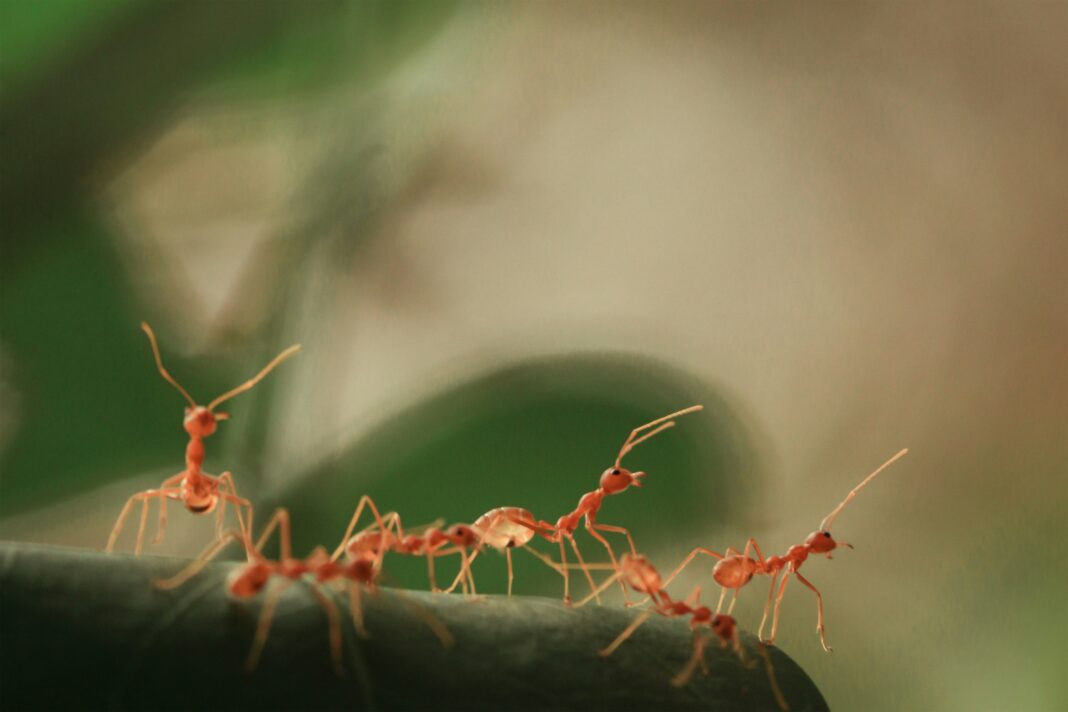“Oh no!” I jumped towards the bag of chocolates, which now had a parade of dots moving out in perfect congregation. I squinted to look closer, Ants.
Somehow, these insects had so thoroughly and seamlessly integrated themselves into homes, hotels, pavement cracks, and construction sites. One can think of any place, particularly in Pakistan, and know with an awkward sense of comfort that their one and only friend, the ants, will be ever-present. With there being over 16,000 identified species of ants, there’s no shortage of these pesky pests. However, as prevalent as they are, very few of us have taken the time to actually study them. [1]
Edward O. Wilson, author of Tales from the Ant World, talks about how a million years ago, ants, from an external lens, seem almost omnipresent. Even in the past hundred million years, ants seem to have had a strong grip on the world’s insect biomass, dominating a large part of the world’s fauna and flora, yet somehow keeping the ecosystem healthy and intact. [2]
In fact, biologist Danielle Mersch says, “Ants are everywhere and rival humans for the greatest diversity of lifestyles. Ants invented farming and slavery way before the first humans walked the earth. They thrive in deserts, conquer rainforests, and can invade and destroy your house”. [3]

Expanding the nest
Interestingly, ants are a completely matriarchal system with all the roles of foragers, workers, fighters, and caretakers appointed to females. Male ants are strictly required for reproduction and are unable to care for themselves, nor do they provide additional help in the nest, which explains their smaller brain size than the queen’s. Male larvae are kept in underdeveloped nests, which are essentially unable to retain large amounts of heat, to allow for their appropriate growth and development. The future queens, on the other hand, are raised in well-built nests that can retain a lot of heat. [2]
During mating season, both the female and male ants leave the nest in a ceremonious graduation called the ‘nuptial flight’. Ironically, any male or female ant that attempts to leave the nest before the right moment is dragged back by worker ants, which hold onto it by its wings.
After mating, the male ant succumbs to a guaranteed death due to its inability to survive outside or return to its nest. It is usually fed one last meal before it leaves the nest, and if found to have come back, it is pushed out by its initial caretakers.
The female, on the other hand, now begins a long, tiring journey to build a nest of her own. It uses its legs to physically clip off its wings to allow it to move around faster. It can no longer return to its original nest as that would be a threat to her previous ‘ant home’.
Worker ants recognize members of their own nest by the queen’s scent, which eventually spreads and rubs off on all the members of the nest. Hence, the new female queen has no choice but to go on and build a new nest of her own. She must care for the eggs and perform all the common duties until the first set of worker ants are born. Additionally, she may also adopt a technique called social parasitism. Here, the traveling queen ant trespasses into the nest of a different, yet related, ant species and kills their queen.
Without a shred of loyalty, the workers now accept the new stranger as their queen and begin raising the imposter’s eggs until her offspring outnumber the older nest, resulting in a pure colony.
Ants: The intelligent savages
Ants are renowned in the natural world for their cruel, unforgiving nature. In a human society and most of the animal kingdom, older animals are appointed less strenuous duties, and the youth are pushed to do the difficult, gruesome tasks.
However, in the world of ants, there is quite the opposite trend. The younger worker ants are initially appointed to take care of the brood, eventually shifting to interior repair duties. The older the ant gets, the more it is pushed to foraging and protection duties, the equivalent of equipping the aunties in the neighborhood to go fight wars with their jharoos.
Despite their harsh nature, ants are known to be calculatedly collaborative. Armin Scheib, in his illustrative book ‘The Ant Collective’, mentions that a single worker ant that consumes food stores it inside itself as a ball called the crop, which is enough to feed 80 other workers [4]. Two-thirds of the ant’s diet is plant-based, and one-third is animal-based. Ant trails that lead to more permanent sources of food, like an aphid nest, may actually persist for years!
Ants are also extremely hygienic creatures. They carry all their waste out of their nest and place it in heaps far away from their nest and hunting area, forming a sort of ‘trash boundary’.
One may wonder what happens if an ant drops dead inside the nest. If it’s dead and has started decomposing, the ants will dispose of it immediately. However, if the ant is just mangled and dying, the other ants may actually end up snacking on their dying sister.
Ants can be fascinating creatures, and the more I look into them for this article, the more fascinated I am! I’ve tried to share the most interesting tidbits in hopes that they may push you to explore more on your own.
To help you, I’ve compiled a list of future recommendations that are a nice evening read regardless of one’s initial knowledge in science.
Further Recommendations
- The Ant Collective: Inside the World of an Ant Colony by Armin Shieb is a wonderful book that handpicks the most interesting facts and expands on them with beautiful illustrations. It is a truly fun experience reading through this book, regardless of whether you are fascinated by insects or accidentally stumbled upon this page [2].
- Tales from the Ant World by E. O. Wilson is an amazing book that lives up to the praise enjoyed by the author. Dr. Wilson paints an awesome picture which leaves you flickering between laughter, feeling mortified, to losing yourself deep in thought [4]!
- Build a DIY ant nest! For all those readers who want to practically observe ants at work, a fun way to do so is to form a DIY glass jar ant farm! You need 2 jars, some soil, a couple of ants, and some time to let them do some digging [4]!
References:
- Wetterer, J. K. (2009). Worldwide spread of the ghost ant, Tapinoma melanocephalum (Hymenoptera: Formicidae). Myrmecological News, 12, 23-33.
- Schieb, A. (2024). The ant collective: Inside the world of an ant colony. Princeton University Press.
- TEDx Talks. (2014, Nov 20). Fascinating ants — lessons for humans? | Danielle Mersch | TEDxZurich [Video]. YouTube. https://www.youtube.com/watch?v=qUu1kXT7tXE
- Wilson, E. O. (2021a). Tales from the ant world. Liverright Publishing Corporation, a division of W.W. Norton & Company.
More from the author: Finding Your North Star: Dr Mohammad Mustafa on Passion, Purpose, and Careers

Abeer Asif is a Fulbright scholar and science enthusiast currently pursuing her graduate studies at Worcester Polytechnic Institute, USA. Her hobbies include cycling, learning martial arts, and spending evenings with her tri-pawed cat, Princess. She hopes to introduce people to the wonders of biology through science communication and writing.

